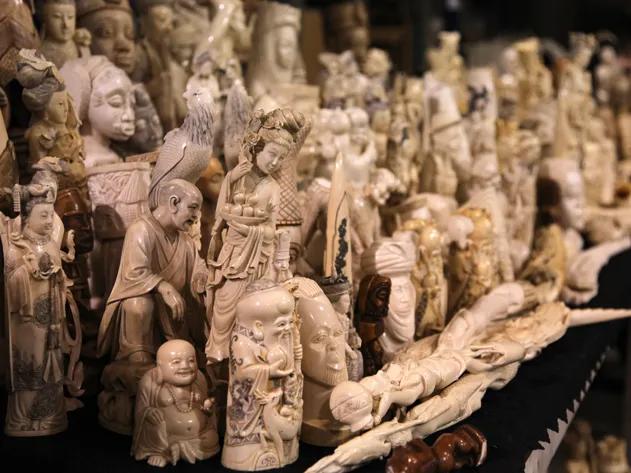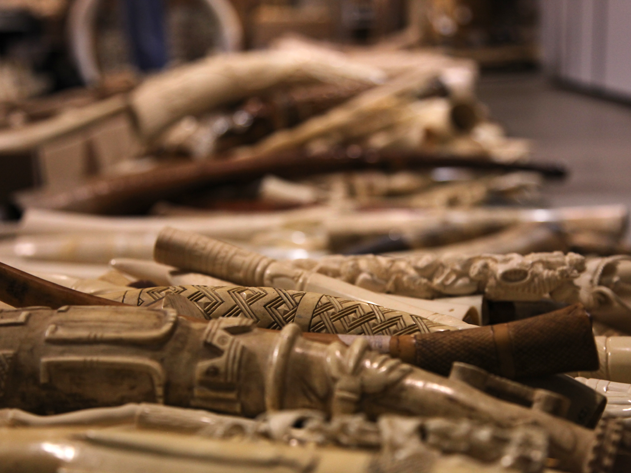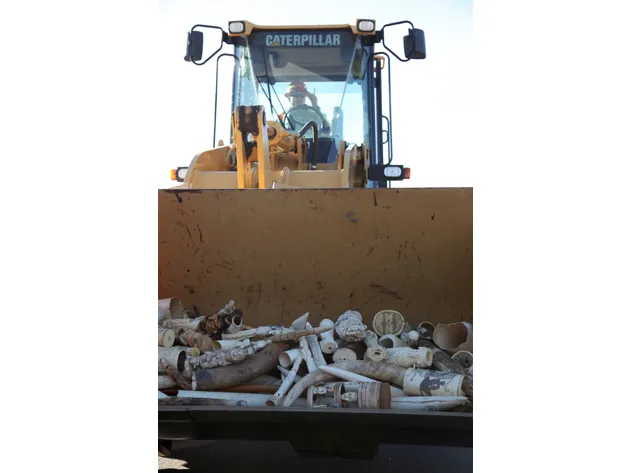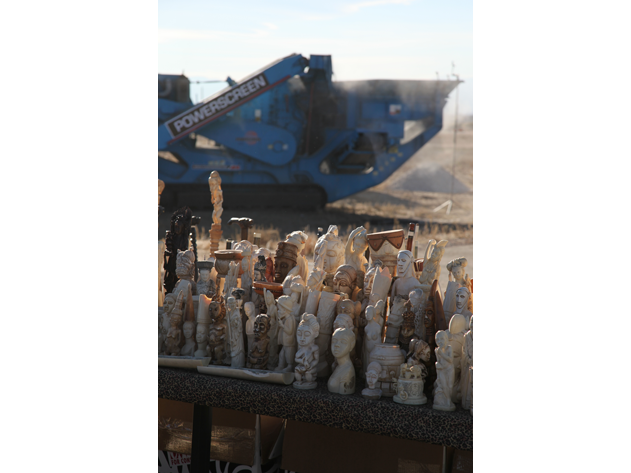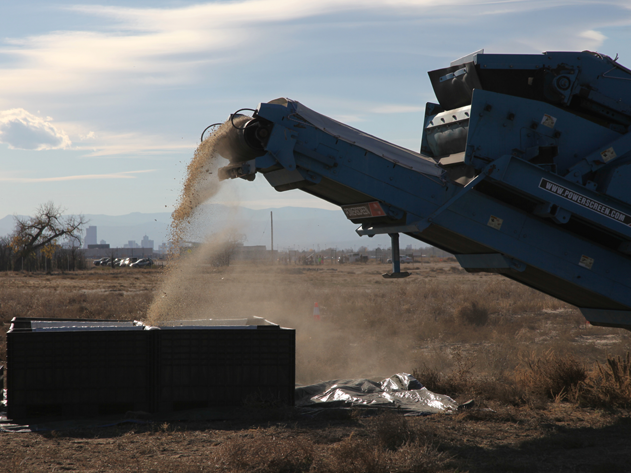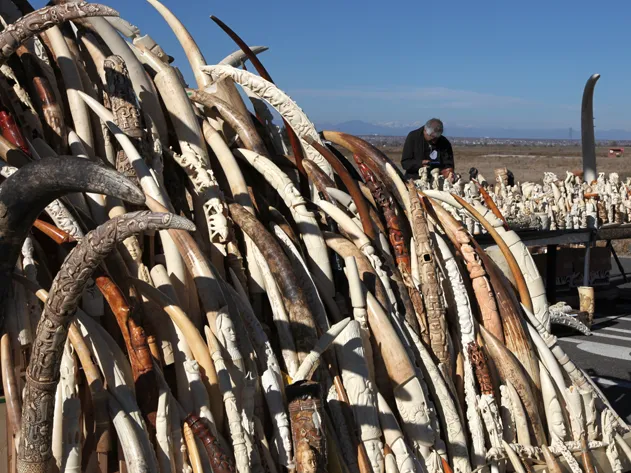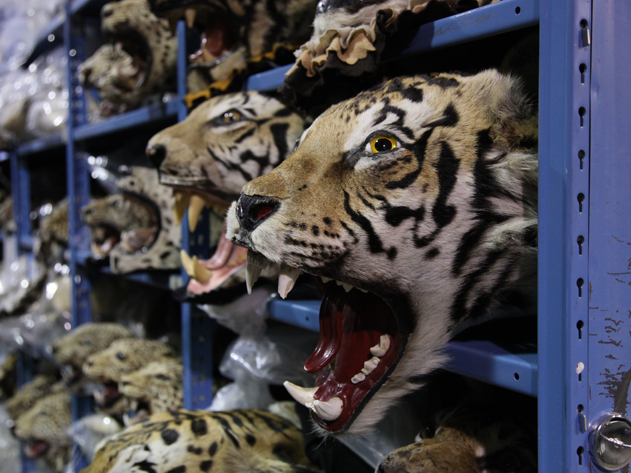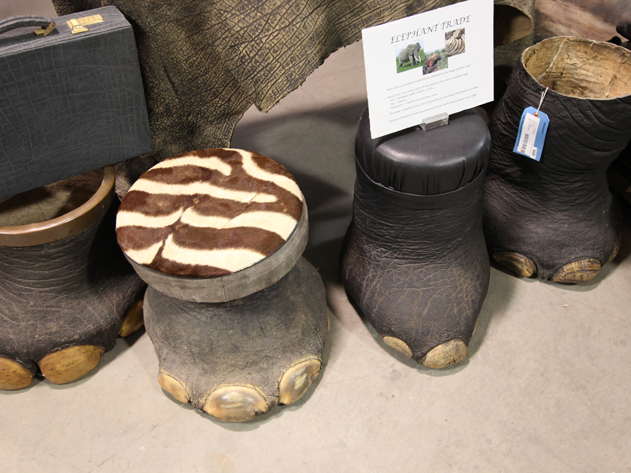Why is the U.S. Government Crushing Six Tons of Valuable Ivory?
Rather than sell the luxury item, the Fish and Wildlife Service thinks that they’ve found a new tactic to save elephants
/https://tf-cmsv2-smithsonianmag-media.s3.amazonaws.com/filer/ivory-crush-collection-hero.png)
Last Thursday, in the bison-dotted grasslands northeast of Denver, U.S. Fish and Wildlife Service workers in hard hats and orange vests turned millions of dollars into dust. A bulldozer hoisted intricate carvings, walking sticks, pool cues, jewelry and trinkets made of ivory, alongside hundreds of elephant tusks, into a blue rock grinder the size of a tractor-trailer. In just a few moments, the rumbling gullet spit out a cloud of dust and a stream of bite-size chips of ivory, now rendered valueless.
For 25 years, FWS special agents have been accumulating the six-ton pile of ivory goods seized from busted illegal wildlife traffickers. But it only took a matter of hours—and half-a-dozen bulldozer loads—to pulverize it all.
“Global demand for ivory is soaring, fueling a slaughter of horrific proportions,” says Dan Ashe, the director of the U.S. Fish and Wildlife Service. “We have a choice. We will either be witness or solution to an unfolding ecological disaster. By crushing this ivory, we’re saying that we intend to lead the world toward a solution.”
The FWS’s goals for the ivory crush—the first event of its kind in the United States—are to deter poachers and traffickers and to encourage other governments to destroy their own stockpiles and tighten anti-trafficking measures. Since 2007, poaching has doubled, and last year alone, about 35,000 elephants died at the hands of illegal hunters. Since the poaching crisis of the 1980s, traffickers have become more sophisticated and ruthless. Today, some arm themselves with AK-47s and night-vision goggles, and many have organized into syndicates with ties to terrorist organizations such as Darfur’s Janjaweed or Somalia’s Al-Shabab, which was responsible for the violence in a Nairobi mall in September.
See the devastating impact of elephant poaching in this interactive map
In July, President Obama responded by promising $10 million for anti-poaching projects in African countries. He also established a presidential task force to devise strategies to slow wildlife trafficking, which is now the third-largest international crime business, valued at about $10 billion after the drug trade and human trafficking.
“What’s become clear is the scale and threat posed by wildlife trafficking,” says Robert Dreher, the acting assistant attorney general for the Department of Justice’s Environment and Natural Resources Division, who came to Denver to witness the crush. “It is of course a terrible conservation crisis, but it is also a threat to national security and international order.”
It’s easy to understand how poaching has mushroomed. Newfound wealth in countries like China, Vietnam and Thailand is fueling demand for luxury items including rhino horns and ivory, causing prices to skyrocket. Now, pound for pound, the dense white stuff is worth more than gold. Even though anti-poaching and anti-trafficking laws exist in many African countries, they are often poorly enforced. Shipping containers with tusks now depart from ports such as Dar Es Salaam, Tanzania; Lomé, Togo; and Durban, South Africa, on their way to markets in Asia.
In the United States, importing freshly harvested ivory has been illegal since 1989, when President George H. W. Bush signed a moratorium on imports, prompting an international ban that helped elephant populations rebound in the 1990s. However, it’s still legal under federal regulations to trade antique ivory imported before 1989 and to import hunting trophies destined for personal use.
These rules can make law enforcement challenging. FWS special agents intercept many illegal imports, using x-rays to sleuth tusks hidden in wooden furniture and even finding it in plain sight in the windows of tony Manhattan antiques shops. But the vast majority is caught at points of entry into the country – smugglers bring in vast shipments, sometimes still in tusk form and other times already carved. Experts estimate that the six-ton stockpile destroyed last week amounted to only about 10% of the total that is smuggled into the U.S., which is the second largest ivory market in the world after China.
“Once it’s in the country, controlling unlawful trade is tough,” says Steve Oberholtzer, the FWS special agent in charge for law enforcement. It’s difficult for agents to tell—and harder to prove—what is a genuine antique, especially now that some traffickers dye freshly harvested ivory to make it look old. Dating ivory has been impossible until very recently. Bomb-curve dating, a new testing method that came out this summer, allows scientists to detect radioactive isotopes within ivory that can date it to within a year of the elephant's death. It works by identifying the concentration of carbon-14, which has been in the atmosphere at varying levels since the atomic bomb tests. The method is still very new; the FWS doesn't use it yet.
The FWS chose to crush their stockpile of ivory partly because it is so difficult to tell legal ivory from illegal ivory, and letting any reenter the market muddies the waters.
Although the agency wouldn’t sell it as a matter of policy, past sales of stockpiled ivory in Africa in 1998 and 2008 significantly fueled the market, rather than satiating demand.
Several non-profit organizations, including the World Wildlife Federation and International Fund for Animal Welfare, are urging lawmakers to enact a moratorium on all ivory trade. Meanwhile, as the presidential task force works on an anti-trafficking strategy to be unveiled early next year, a group of non-profits and seven African governments recently agreed to an $80 million plan brokered by the Global Clinton Initiative to organize efforts like hiring guards and tightening customs facilities over the next three years.
Currently, between 420,000 and 650,000 elephants remain in the wild, and as the price of ivory soars, poachers are emboldened. This fall, hunters poisoned a watering hole in Zimbabwe’s Hwange National Park with cyanide, killing more than 80 elephants in one swoop. Other poachers capitalize on elephants’ emotional intelligence and allegiance to matriarch-led clans. Killing the matriarch, they know, will send the rest of the herd into confusion, making for an easy slaughter.
“What it looks like from the seizures [of illegally trafficked tusks] is they’re now killing whole families,” says Michelle Gadd, an elephant biologist and FWS Africa program officer. The agency is increasingly seeing tiny tusks from young elephants.
All of these goods are housed at the National Wildlife Property Repository, near the site of the crush. It’s where the FWS stores evidence that has been seized from illegal wildlife traffickers but not yet used in trial or shipped to educational institutions. With some 1.5 million items, it is a catalog of horrors organized by species, from rows of stuffed tiger heads to shelves full of cobra-skin boots and stacks of gutted sea turtle carapaces.
Now, of course, the ivory is gone, and the tiny chips will be reused for educational displays for zoos and other institutions. But there is still a row in the repository that is devoted to elephants, with boxes labeled “elephant teeth/toenails,” “elephant skin wallets,” and “elephant skin belts.” Nearby, four severed elephant feet sit lifelessly on the floor. Staring at this warehouse, a macabre shrine to lost life, a visitor has to wonder how soon ivory from illegal traffickers will begin streaming in again.
